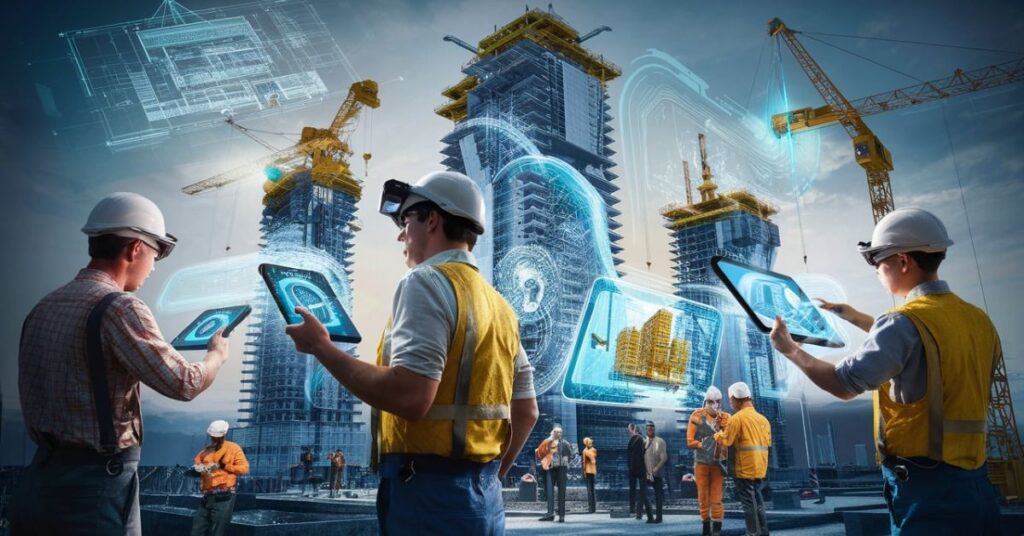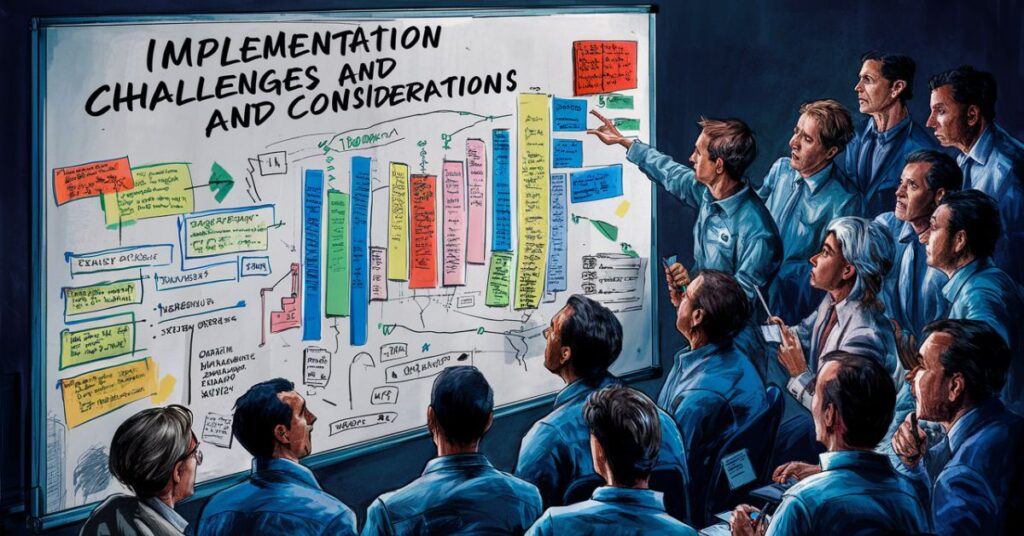Augmented Reality (AR) in construction integrates digital information with the physical environment, allowing workers to visualize and interact with project data in real-time. It enhances accuracy, efficiency, and safety by providing detailed 3D models and real-time data overlays.
Imagine walking onto a construction site and instantly seeing a digital overlay of the entire project, pinpointing potential issues before they arise. Picture workers equipped with AR glasses that provide real-time guidance, reducing errors and rework.
Augmented Reality technology enables the overlay of digital models onto physical spaces, aiding in tasks such as site planning, progress tracking, and quality control. Companies are leveraging Augmented Reality to streamline workflows, enhance collaboration, and improve project outcomes. With AR, the construction industry is poised to achieve unprecedented levels of precision and efficiency.
Understanding Augmented Reality in Construction
Augmented Reality (AR) is a technology that overlays digital information onto the real world, enhancing the user’s perception and interaction with their environment. Core concepts include real-time interaction, 3D registration, and the seamless integration of virtual and physical elements.
Benefits of AR in Construction Projects
- Improves accuracy and efficiency by visualizing complex structures.
- Helps detect potential issues early.
- Enhances collaboration and communication among team members.
- Provides a shared, interactive view of the project.
Applications of AR in Construction

Virtual Modeling and Design Visualization
- Augmented Reality enables the creation of virtual models, allowing stakeholders to visualize the design in a real-world context.
- It helps in identifying design flaws and making adjustments before construction begins, saving time and resources.
On-Site Project Management and Collaboration
- AR assists in on-site project management by providing real-time data and visual overlays, improving accuracy and decision-making.
- It enhances collaboration among team members by enabling them to share and interact with the same augmented view, facilitating better communication and coordination.
Implementation Challenges and Considerations

Integration with Existing Technologies
Integrating AR with existing construction technologies can be complex and requires significant planning and resources. Ensuring compatibility and smooth data exchange between AR systems and current tools is crucial for effective implementation.
Training and Adoption in the Construction Industry
Training workers to effectively use AR technology is essential for its successful adoption in construction projects. Overcoming resistance to change and demonstrating the tangible benefits of AR can help in gaining industry-wide acceptance and utilization.
Read this Blog: Mines Game Hack: Ethical Considerations and Methods
Case Studies and Success Stories

Augmented Reality (AR) is increasingly being used in the construction industry to enhance productivity and accuracy. Here are some notable examples:
1. On-site Visualization and Design
AR allows architects and engineers to visualize construction plans overlaid onto physical sites. For instance, using AR goggles, construction teams can see virtual models superimposed over real structures, helping them assess design compatibility and make real-time adjustments.
2. Safety Training and Simulation
AR is utilized for safety training by simulating hazardous scenarios in a controlled environment. Workers can practice safety protocols and emergency procedures using AR headsets, improving their readiness and reducing on-site accidents.
3. Remote Collaboration and Project Monitoring
AR facilitates remote collaboration among dispersed teams and stakeholders. By sharing augmented views of construction progress and models, project managers can provide real-time feedback and updates, fostering efficient communication and decision-making.
Future Trends and Innovations

Augmented Reality (AR) is poised to undergo significant advancements in the construction industry, transforming various aspects of project management and execution. Here are some predictions for its evolution:
1. Enhanced Design and Planning Capabilities
AR will enable more sophisticated design visualization and planning. Future advancements may include AI-driven simulations that predict construction challenges and optimize design solutions in real-time. This will streamline the planning phase, reduce errors, and improve overall project efficiency.
2. Integration with IoT and BIM
AR is likely to integrate more deeply with Internet of Things (IoT) devices and Building Information Modeling (BIM) systems. This integration will enable AR to access and interact with real-time data from sensors embedded in construction materials and equipment. Workers can then use AR to visualize data overlays, monitor equipment performance, and enhance decision-making on-site.
3. Wearable and Mobile AR Solutions
The evolution of wearable AR devices and mobile applications tailored for construction will continue. These solutions will become more ergonomic, durable, and capable of handling complex AR overlays. Workers will have hands-free access to critical information, reducing the need for paper plans and allowing for more efficient task execution on-site.
Impact of AR on Safety and Efficiency
Augmented Reality (AR) is revolutionizing safety protocols in the construction industry by providing real-time visualizations and simulations. AR technology allows workers to overlay safety guidelines and hazard warnings onto their field of view, enhancing awareness of potential dangers.
AR plays a pivotal role in improving project efficiency and timeline management by facilitating better communication and decision-making among team members. Through AR-enhanced visualization, project managers can monitor progress in real-time and identify potential bottlenecks or deviations from the schedule.
Advantages of AR Over Traditional Techniques
| Advantage | Description |
| Enhanced visualization | Allows stakeholders to see virtual models overlaid on real-world construction sites. |
| Improved accuracy | Reduces errors in measurements and design alignments, leading to better construction outcomes. |
| Real-time collaboration | Facilitates seamless communication and decision-making among project teams. |
| Cost savings and efficiency improvements | Minimizes rework and delays, optimizing project timelines and budgets. |
| Enhanced project documentation and reporting | Provides detailed records and insights into project progress and changes. |
Conclusion
Augmented Reality (AR) is poised to revolutionize construction practices by introducing cutting-edge capabilities in visualization, efficiency, and safety. Its ability to overlay digital information onto physical environments enables stakeholders to visualize complex designs in real-time, improving decision-making and design accuracy.
By integrating AR into daily workflows, construction teams can foresee potential challenges early, make informed adjustments, and optimize project planning processes. This transformative technology promises not only to enhance productivity but also to elevate the quality and precision of construction projects.
Embracing AR signifies more than just adopting a technological tool; it represents a paradigm shift towards innovation and efficiency in the construction industry. As firms embrace AR’s potential, they are not only investing in advanced construction techniques but also in a future where buildings are constructed more intelligently and sustainably.
Frequently Asked Questions
What is Augmented Reality (AR) in construction?
Augmented Reality in construction integrates digital information and models into real-world environments, enhancing visualization and project management.
How does AR benefit construction projects?
AR improves accuracy in design and construction, facilitates better collaboration among stakeholders, and enhances efficiency in project execution.
What are the challenges of implementing AR in the construction industry?
Integration with existing technologies, training requirements for personnel, and initial investment costs are key challenges in adopting AR in construction.
Can AR improve safety on construction sites?
Yes, AR enhances safety by providing real-time hazard alerts, virtual training simulations, and visual overlays for safer equipment operation.
What are the future trends for AR in construction?
Future trends include advancements in AR hardware, expanded use of AR for maintenance and facility management, and greater integration with Building Information Modeling (BIM) systems.








